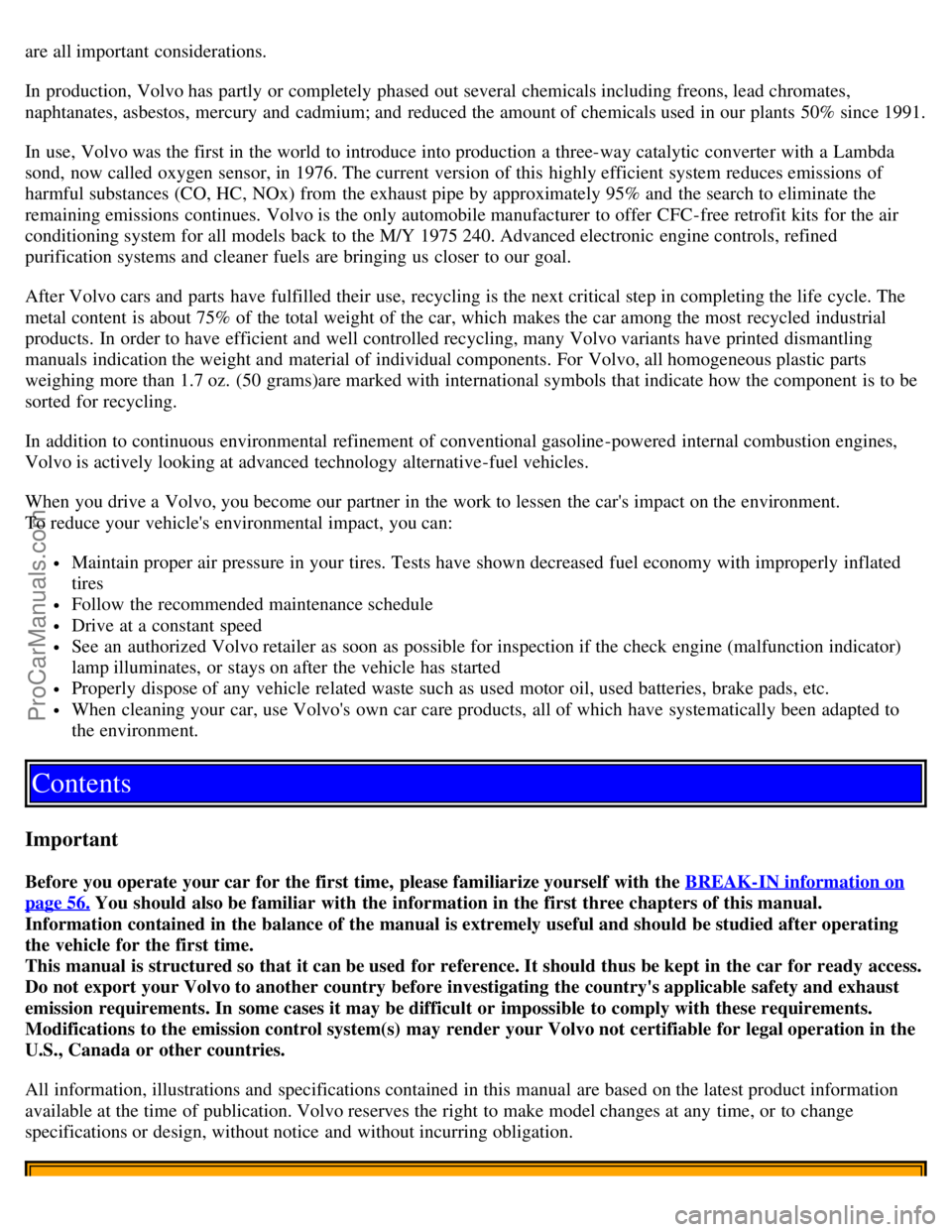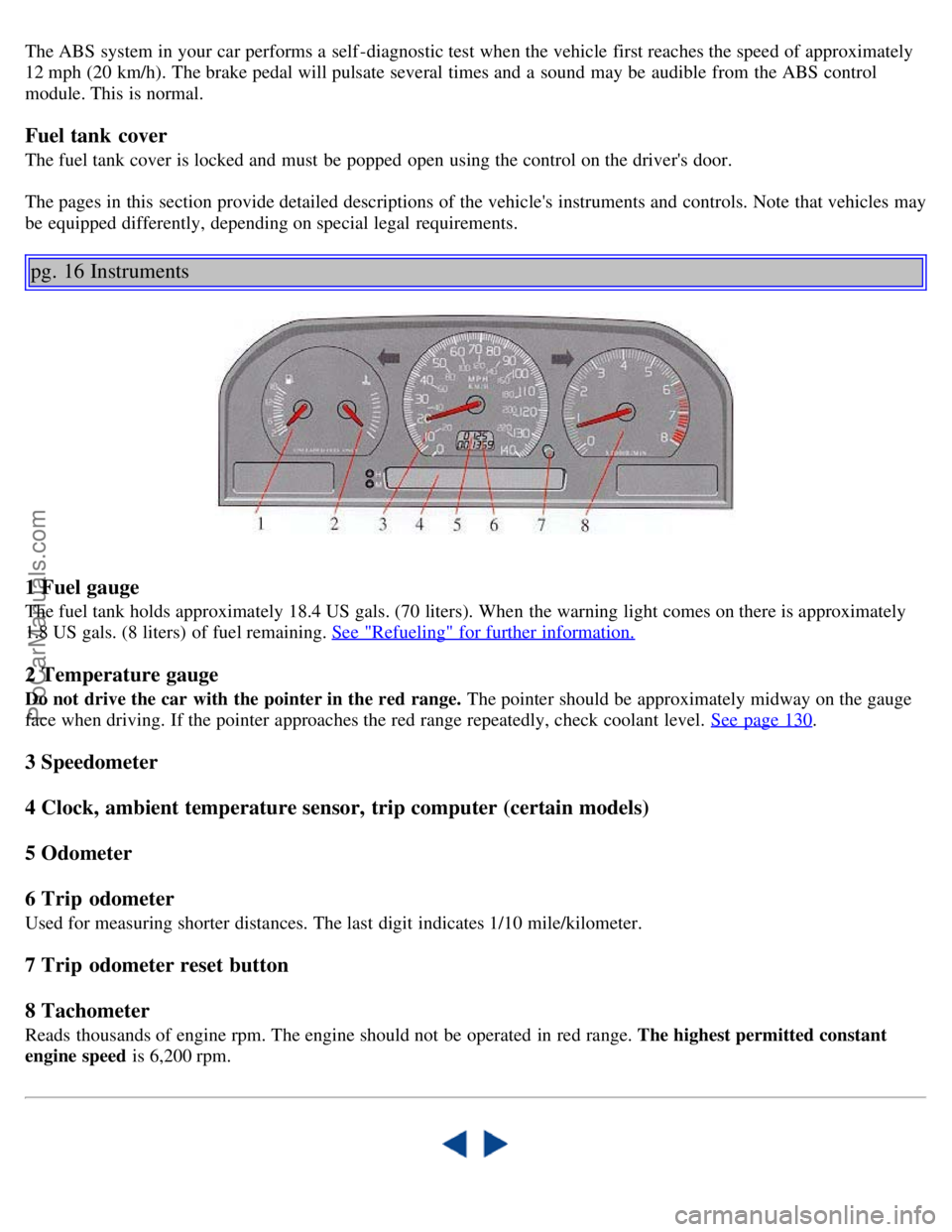sensor VOLVO C70 1998 Owners Manual
[x] Cancel search | Manufacturer: VOLVO, Model Year: 1998, Model line: C70, Model: VOLVO C70 1998Pages: 38, PDF Size: 0.71 MB
Page 2 of 38

are all important considerations.
In production, Volvo has partly or completely phased out several chemicals including freons, lead chromates,
naphtanates, asbestos, mercury and cadmium; and reduced the amount of chemicals used in our plants 50% since 1991.
In use, Volvo was the first in the world to introduce into production a three-way catalytic converter with a Lambda
sond, now called oxygen sensor, in 1976. The current version of this highly efficient system reduces emissions of
harmful substances (CO, HC, NOx) from the exhaust pipe by approximately 95% and the search to eliminate the
remaining emissions continues. Volvo is the only automobile manufacturer to offer CFC-free retrofit kits for the air
conditioning system for all models back to the M/Y 1975 240. Advanced electronic engine controls, refined
purification systems and cleaner fuels are bringing us closer to our goal.
After Volvo cars and parts have fulfilled their use, recycling is the next critical step in completing the life cycle. The
metal content is about 75% of the total weight of the car, which makes the car among the most recycled industrial
products. In order to have efficient and well controlled recycling, many Volvo variants have printed dismantling
manuals indication the weight and material of individual components. For Volvo, all homogeneous plastic parts
weighing more than 1.7 oz. (50 grams)are marked with international symbols that indicate how the component is to be
sorted for recycling.
In addition to continuous environmental refinement of conventional gasoline-powered internal combustion engines,
Volvo is actively looking at advanced technology alternative-fuel vehicles.
When you drive a Volvo, you become our partner in the work to lessen the car's impact on the environment.
To reduce your vehicle's environmental impact, you can:
Maintain proper air pressure in your tires. Tests have shown decreased fuel economy with improperly inflated
tires
Follow the recommended maintenance schedule
Drive at a constant speed
See an authorized Volvo retailer as soon as possible for inspection if the check engine (malfunction indicator)
lamp illuminates, or stays on after the vehicle has started
Properly dispose of any vehicle related waste such as used motor oil, used batteries, brake pads, etc.
When cleaning your car, use Volvo's own car care products, all of which have systematically been adapted to
the environment.
Contents
Important
Before you operate your car for the first time, please familiarize yourself with the BREAK-IN information on
page 56. You should also be familiar with the information in the first three chapters of this manual.
Information contained in the balance of the manual is extremely useful and should be studied after operating
the vehicle for the first time.
This manual is structured so that it can be used for reference. It should thus be kept in the car for ready access.
Do not export your Volvo to another country before investigating the country's applicable safety and exhaust
emission requirements. In some cases it may be difficult or impossible to comply with these requirements.
Modifications to the emission control system(s) may render your Volvo not certifiable for legal operation in the
U.S., Canada or other countries.
All information, illustrations and specifications contained in this manual are based on the latest product information
available at the time of publication. Volvo reserves the right to make model changes at any time, or to change
specifications or design, without notice and without incurring obligation.
ProCarManuals.com
Page 9 of 38

The ABS system in your car performs a self -diagnostic test when the vehicle first reaches the speed of approximately
12 mph (20 km/h). The brake pedal will pulsate several times and a sound may be audible from the ABS control
module. This is normal.
Fuel tank cover
The fuel tank cover is locked and must be popped open using the control on the driver's door.
The pages in this section provide detailed descriptions of the vehicle's instruments and controls. Note that vehicles may
be equipped differently, depending on special legal requirements.
pg. 16 Instruments
1 Fuel gauge
The fuel tank holds approximately 18.4 US gals. (70 liters). When the warning light comes on there is approximately
1.8 US gals. (8 liters) of fuel remaining. See "Refueling" for further information.
2 Temperature gauge
Do not drive the car with the pointer in the red range. The pointer should be approximately midway on the gauge
face when driving. If the pointer approaches the red range repeatedly, check coolant level. See page 130
.
3 Speedometer
4 Clock, ambient temperature sensor, trip computer (certain models)
5 Odometer
6 Trip odometer
Used for measuring shorter distances. The last digit indicates 1/10 mile/kilometer.
7 Trip odometer reset button
8 Tachometer
Reads thousands of engine rpm. The engine should not be operated in red range. The highest permitted constant
engine speed is 6,200 rpm.
ProCarManuals.com
Page 16 of 38

Manual transmission
The following speeds should not be exceeded during the break-in period: Up to 600 miles
(1000 km)600 - 1,200 miles
(1000 - 2000 km)
1st gear 20 mph (30 km/h)25 mph (40 km/h)
2nd gear 30 mph (50 km/h)40 mph (70 km/h)
3rd gear 45 mph (80 km/h)65 mph (100 km/h)
4th gear 70 mph (110 km/h)80 mph (130 km/h)
5th gear/overdrive 80 mph (130 km/h)95 mph (150 km/h)
Posted speed limits should not be exceeded.
Deposit control gasoline (detergent additives)
Volvo recommends the use of gasoline containing deposit control additives. These additives have shown to be efficient
in keeping injectors and intake valves clean. Consistent use of deposit control gasolines will help ensure good
driveability and fuel economy. If you are not sure whether the gasoline contains deposit control additives, check with
the service station operator.
Unleaded Fuel
Each Volvo has a three-way catalytic converter and must use only unleaded gasoline. U.S. and Canadian regulations
require that pumps delivering unleaded gasoline be labeled "UNLEADED". Only these pumps have nozzles which fit
your car's filler inlet. It is unlawful to dispense leaded fuel into a vehicle labeled "unleaded gasoline only". Leaded
gasoline damages the three-way catalytic converter and the heated oxygen sensor system. Repeated use of leaded
gasoline will lessen the effectiveness of the emission control system and could result in loss of emission warranty
coverage. State and local vehicle inspection programs will make detection of misfueling easier, possibly resulting in
emission test failure for misfueled vehicles.
NOTE: Some U.S. and Canadian gasolines contain an octane enhancing additive called methyl-cyclopentadienyl
manganese tricarbonyl (MMT). If such fuels are used, your Emission Control System performance may be affected,
and the Malfunction Indicator Lamp located on your instrument panel may light. If this occurs, please return your
vehicle to an authorized Volvo retailer for service.
pg. 57 Fuel requirements, Refueling
Octane Rating
Volvo engines are designed for optimum performance on unleaded premium gasoline with an octane rating. AKI of 91,
or above. AKI (ANTI KNOCK INDEX) is an average of the Research Octane Number, RON, and the Motor Octane
Number, MON, (RON + MON/ 2).
The minimum octane requirement is AKI 87 (RON 91).
Gasoline containing alcohol and ethers
"Oxygenated fuels"
Some fuel suppliers sell gasoline containing "oxygenates" which are usually alcohols or ethers. In some areas, state or
local laws require that the service pump be marked indicating use of alcohol or ethers. However, there are areas in
which the pumps are unmarked. If you are not sure whether there is alcohol or ethers in the gasoline you buy, check
with the service station operator.
To meet seasonal air quality restrictions, some states require the use of "oxygenated" fuel in certain areas.
Volvo allows the use of the following "oxygenated fuels; however, the octane ratings listed on this page must still be
met.
Alcohol — Ethanol
ProCarManuals.com
Page 31 of 38

Manual transmission fluidQuality: Volvo synthetic gearbox oil
1161423
Capacity: 2.2 US qts (2.1 liters)
Power steering fluid Quality: ATF Capacity: 0.85 US qts. (0.8 liters)
Brake fluid Quality: DOT 4+ Capacity: 0.64 US qts. (0.6 liters)
* Add 0.95 qts. (0.9 liters) if the oil cooler has been drained
All specifications are subject to change without notice.
pg. 125 Engine
Engine
Liquid-cooled gasoline, 5-cylinder, in-line engine. Aluminum alloy cylinder block with cast-iron cylinder liners cast
directly into block. Aluminum alloy cylinder head with double overhead camshafts and separate intake and outlet
channels.
Engine lubrication is provided by an eccentric pump driven from the crankshaft. Full-flow type oil filter. Exhaust
emission control accomplished by multiport fuel injection, heated oxygen sensor(s) and three-way catalytic converter.
Designation: Volvo B 5254 T
Output 190 hp at 5100 rpm (142 kw 85 rps)
Max torque 199 ft. lbs. at 1800 -4998 rpm (270 Nm/30 -83.3 rps)
Number of cylinders 5
Bore 3.27" (83 mm)
Stroke 3.54" (90 mm)
Displacement 2.4 liters
Compression ratio 9.0:1
Number of valves 20
Valve clearance Self -adjusting
Designation: Volvo B 5234 T3
Output 236 hp at 5100 rpm (176 kw/85 rps)
Max torque 243 ft. lbs. at 2700 -5100 rpm (330 Nm/45 -85 rps)
Number of cylinders 5
Bore 3.19" (81 mm)
Stroke 3.54" (90 mm)
Displacement 2.3 liters
Compression ratio 8.5:1
Number of valves 20
Valve clearance Self -adjusting
All specifications are subject to change without notice.
Contents | Top of Page
ProCarManuals.com
Page 35 of 38

pg. 188 Index
A
ABS........................................17Air conditioning...........................35Air mix....................................33Air vents..................................33Airbag (SIPS)...............................8Airbag (SRS)................................4Alarm......................................44Ambient temperature sensor.................25Anti -lock Brake System (ABS).........17, 19,70Ashtrays...................................31Audio systems
General information.....................184
SC-813..................................132 SC-816..................................145 SC-900..................................161Auto -dim (rear -view mirror)................48Automatic car washing.....................103Automatic daytime running lights...........24Automatic transmission...........61,62,63,127 Driving mode selector....................62Automatic transmission fluid..........117,124
B
Battery................................72,128Battery drain - avoiding...................54Battery maintenance.......................122Booster cushion............................11Brake failure warning light.............17,18Brake fluid...........................116,124Brake fluid warning light..................18Brake system...............................70Brake warning light........................17Break -in period............................56Bulb failure warning....................17,19Bulbs.....................................128Bulbs - replacing..........................85
C
Capacities................................127Catalytic converter........................69Central locking button.....................36Chains (snow)..............................77Changing a wheel...........................82Child booster cushion......................11Child Restraint Anchorages..................9Child safety...............................11Clock......................................16Clock - resetting..........................25Clutch fluid..............................116Coolant - checking/changing...............120Coolant level sensor.......................19Coolant level warning light................17Cooling system.........................64,126Courtesy lights - front....................49Cruise control.............................29
D
Daytime running lights..................20,24Demister - rear window.....................23Dimensions................................129Distributor ignition system...............126Doors and locks............................42Drive belt................................118Driving economy............................58
E
ProCarManuals.com